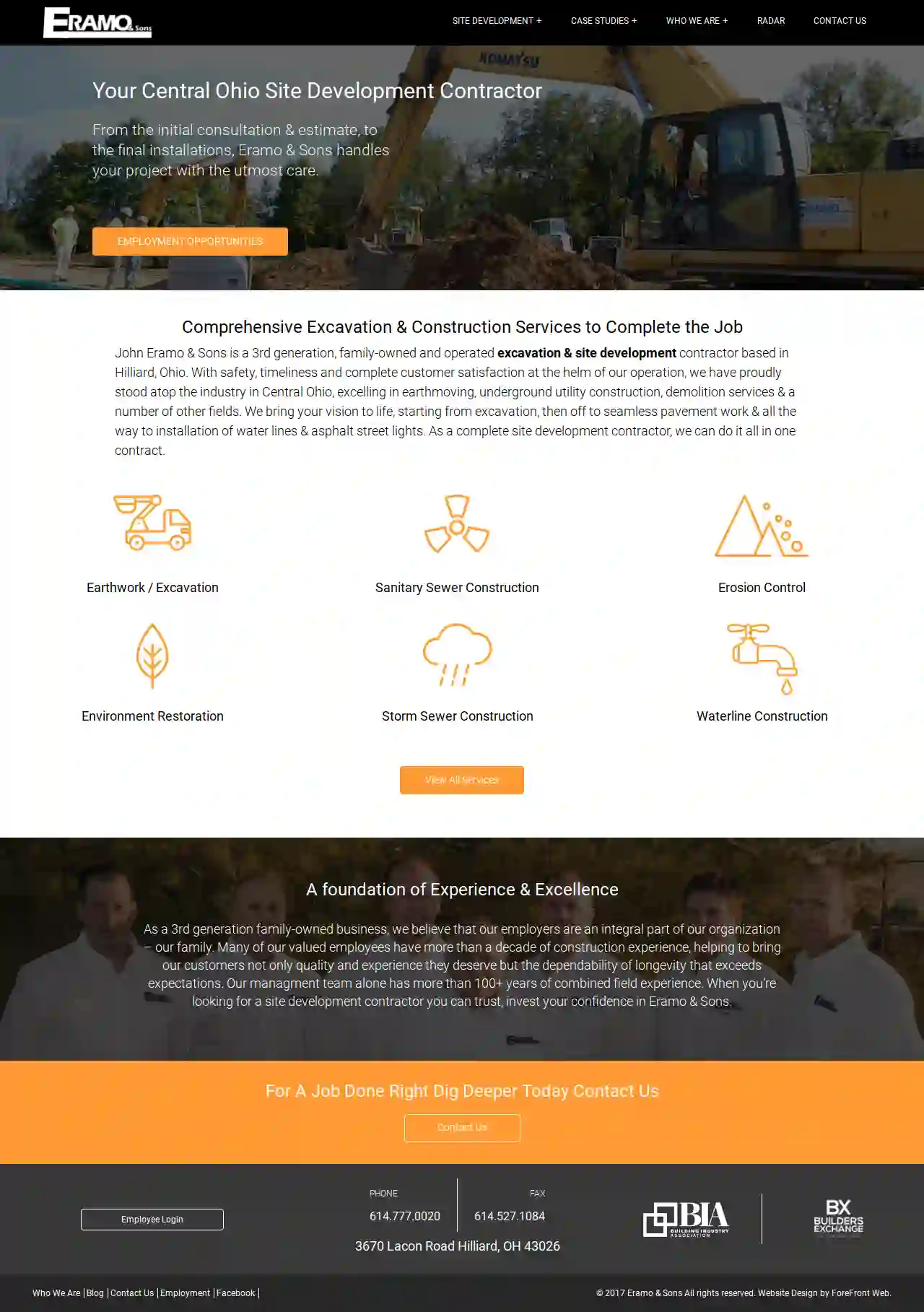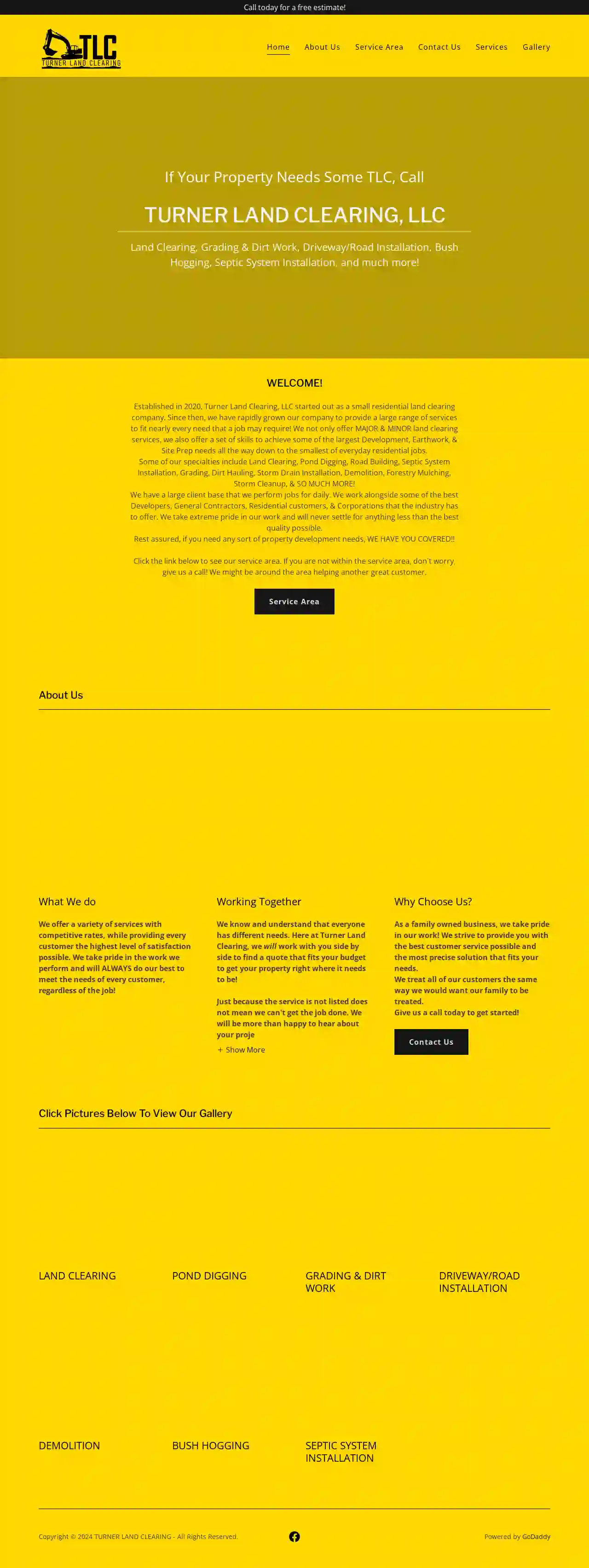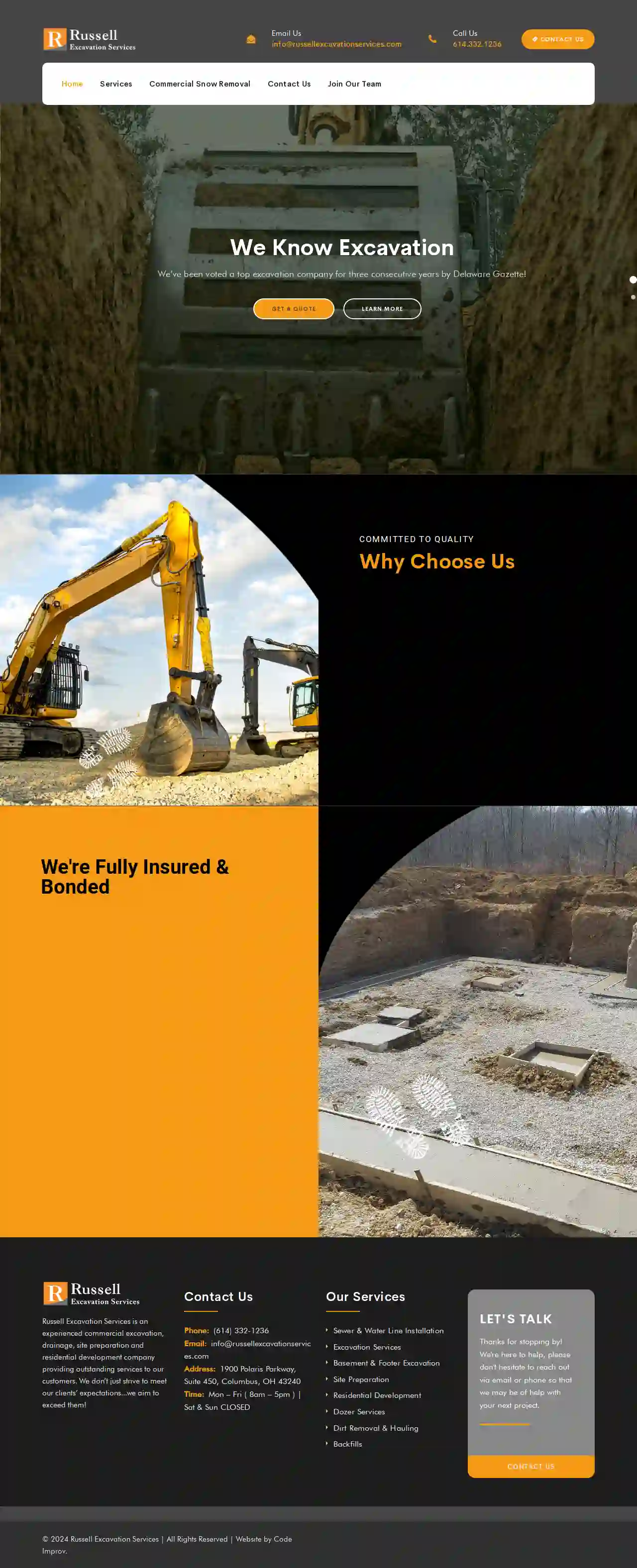Demolition Contractors Rockmart
Find Demolition Experts in Rockmart
Get up to 3 Local Demolition Contractors quotes for your project today! Compare profiles, reviews, accreditations, portfolio, etc... and choose the best offer.

John Eramo & Sons, Inc.
4.26 reviews3670 Lacon Road, Hilliard, 43026, USYour Central Ohio Site Development Contractor From the initial consultation & estimate, to the final installations, Eramo & Sons handles your project with the utmost care. Comprehensive Excavation & Construction Services to Complete the Job John Eramo & Sons is a 3rd generation, family-owned and operated excavation & site development contractor based in Hilliard, Ohio. With safety, timeliness and complete customer satisfaction at the helm of our operation, we have proudly stood atop the industry in Central Ohio, excelling in earthmoving, underground utility construction, demolition services & a number of other fields. We bring your vision to life, starting from excavation, then off to seamless pavement work & all the way to installation of water lines & asphalt street lights. As a complete site development contractor, we can do it all in one contract. A foundation of Experience & Excellence As a 3rd generation family-owned business, we believe that our employers are an integral part of our organization – our family. Many of our valued employees have more than a decade of construction experience, helping to bring our customers not only quality and experience they deserve but the dependability of longevity that exceeds expectations. Our managment team alone has more than 100+ years of combined field experience. When you’re looking for a site development contractor you can trust, invest your confidence in Eramo & Sons.
- Services
- Why Us?
- Gallery
Get Quote
Coastal Grading & Rental Inc
46 reviews1245 Sand Hill Rd, Guyton, GA, 31312, USTo Our Customer's Coastal Grading is committed to providing the highest quality, value-added site preparation services to our coastal Georgia and South Carolina customers. We believe that by creating a successful partnership with our customers throughout the project process, we can exceed their expectations and gain their trust. We pledge to do this through the exceptional performance of every member of the Coastal Grading team. The Short Version Of Our Story Founded in 1981 by Gerald Odom, Coastal Grading began with a modest start. After 10+ years working as a foreman with local asphalt paving companies, Gerald start Coastal Grading and Rental with a pickup truck, a backhoe and a trailer. Gerald’s hard work and integrity paid off quickly growing the company to one of the most highly respected site-work contractors in the Low Country. It became a common theme in the Savannah Market that “no one could out work Gerald Odom”. His dedication set the bar for everyone that joined the Coastal Grading Team. Coastal Grading has provided a wide variety of site-work services throughout the Low Country over the past 40+ year; everything from truck yard maintenance to large warehouse construction. Colonial Terminals yard maintenance, SCAD Ronald C. Waranch Equestrian Center, Ellis Square and Underground Parking Garage, SCAD’s Sands at One West Victory, Benedictine Military School Parade Ground, are only a few of the successful projects of Coastal Grading’s long esteemed history. Gerald’s most successful achievement was building the best commercial grading team in the Savannah Market. After over 50 years in the commercial construction business, Gerald Odom turned over the reigns to Brian Hussey. A well-known, well-respected local businessman, whose father was Roy Hussey, founder of Hussey-Gay-Bell Engineering firm. Brian came “full circle” from holding a survey rod during summer jobs with Hussey-Gay-Bell to owning a civil construction company. It is well known in the commercial construction arena in the Low Country, if you want it done right, hire Coastal Grading. Get To Know Our Team After 40 years of successful leadership in the Site Preparation Industry, Gerald Odum has “passed the torch” to Brian and CG Partnership LLC. Brian brings a unique combination of talents and experiences to his role as the new leader of Coastal Grading including organizational and financial expertise, a strong work ethic, and a commitment to customer satisfaction. Brian is a proven leader with a passion for the construction industry and a deep understanding of the needs of our customers.
- Services
- Why Us?
- Our Team
- Testimonials
- Gallery
Get Quote
Turner Land Clearing, LLC
52 reviewsTownsend, GA, 31331, USAbout Turner Land Clearing, LLC Established in 2020, Turner Land Clearing, LLC began as a small residential land clearing company. Since then, we've expanded rapidly to offer a wide range of services, catering to almost any project need. We specialize in both major and minor land clearing, and we possess the skills to handle large-scale development, earthwork, and site preparation projects, as well as smaller everyday residential jobs. Our expertise encompasses Land Clearing, Pond Digging, Road Building, Septic System Installation, Grading, Dirt Hauling, Storm Drain Installation, Demolition, Forestry Mulching, Storm Cleanup, and much more! We work with a diverse client base, including Developers, General Contractors, Residential customers, and Corporations, and we take immense pride in our work, always striving for the highest quality. If you have any property development needs, we've got you covered! Check out our service area below. If you're outside the service area, don't hesitate to call us. We might be nearby assisting another satisfied customer.
- Services
- Why Us?
- Gallery
Get Quote
GS Excavation & Hydroseeding
57 reviewsColumbus, USWelcome to GS Excavation and Hydroseeding Welcome to GS Excavation and Hydroseeding. Our main goal is to always achieve a high level of customer satisfaction with the services and products that we provide. We offer both Commercial and Residential Excavation, and HydroSeeding. No project is too big or too small for us. We also offer Commercial Snow and Ice removal. Please browse our site to discover what we’re all about. Call us Email us
- Services
- Why Us?
- Gallery
Get Quote
Atlanta Grading & Demolition Services
52 reviewsAtlanta, USAtlanta Land Grading: Your Trusted Partner for Expert Yard Grading and Demolition Atlanta Land Grading specializes in high-quality yard grading and demolition services. Our skilled technicians use cutting-edge equipment to handle all your grading needs, from addressing drainage issues to facilitating new construction. We specialize in creating sustainable landscapes that add value to your property. Contact us today to turn your outdoor dream into a reality! Atlanta's Top Landscape Grading & Demolition Service for Residential, Commercial, and Industrial Needs At Atlanta Grading company we provide variety of services from Grading, Demolition, excavation and clearing. Experience to be Trusted Atlanta Land Clearing and Grading has been providing cost-effective solutions for site grading, pool excavation, demolition, land clearing, and dumpster rentals for over 10 years. With over 10,000 successful projects, we are committed to delivering excellent quality regardless of the project’s scale. Our People and Community At Atlanta Land Grading, our team of experienced experts is dedicated to contributing to the growth and development of the Atlanta community through our work. We actively engage with the community, supporting local initiatives, and fostering a strong bond with our neighbors. Our belief in collaboration with clients and the community helps us create a better, more sustainable future for all.
- Services
- Why Us?
- Gallery
Get Quote
Northeast Georgia Trucking & Grading
522 reviews1411 Old Rock Rd., Greensboro, 30642, USWelcome to Northeast Georgia Trucking & Grading Northeast Georgia Trucking & Grading is where family values and bettering the community are at the heart of everything we do! We're proud to be a locally owned business, founded by one of our own local Loganville and Greensboro natives, Justin and Heather Bailey. With over two decades of experience, our dedication to our industry, reliability, and passion shine through in every service we offer. Our business is deeply rooted in our community, and we've nurtured lasting relationships with local property managers, homeowners, and fellow businesses. At Northeast Georgia Trucking & Grading, we're not just a trucking, hauling and grading company; we're your neighbors and friends. We're here to serve our community with the utmost professionalism, care, and dedication to your unique needs. When you choose us, you're not just choosing a service; you're choosing a trusted partner who shares your commitment to our wonderful Northeast Georgia community.
- Services
- Why Us?
- Testimonials
- Gallery
Get Quote
Rock Solid Excavation LLC
522 reviewsColumbus, USCincinnati's 1st Choice for Excavation Digging Deep, Building Strong: Quality Excavation & Affordable Excavation bringing the results you need. Our goal is your goal No company does well without seeing their customers vision and executing on that. We have been in business for a long time and plan on continuing. Now let us show you that we can make your vision a reality. Who we are Rock Solid Excavation is the brainchild of two Cincinnati natives, Drew Dobyns and Noah Merten. With extensive experience in landscaping, they united to establish a company that redefines construction and excavation services in greater Cincinnati. Our mission is simple – to provide affordable, high-quality services that surpass expectations without compromising budgets. Driven by values of community, transparency, and over-delivery, Rock Solid Excavation is deeply committed to the Cincinnati ethos. Born and raised here, Drew and Noah bring a unique local perspective to every project. As young entrepreneurs, we pride ourselves on the best customer service in Cincinnati, ensuring a response time of 1 day or less. Our dedication extends beyond construction; we’re neighbors invested in the success of the community, delivering transformative projects that leave a lasting legacy. Join us as we redefine construction and excavation services in greater Cincinnati, where Rock Solid Excavation is not just a company; it’s a promise of quality and community impact.
- Services
- Why Us?
- Our Team
- Testimonials
- Gallery
Get Quote
Untavius Land Clearing & Excavation Service
Milledgeville, 31062, USExpertise and Mastery in Every Excavation Service As a certified, bonded, and insured excavation service specialist with over 14 years of experience, I provide unmatched knowledge and dependability throughout Milledgeville, GA. Whether you need help with grading, excavation, demolition, or landscaping, Untavius Land Clearing & Excavation Service can provide effective solutions that meet your requirements. Put your trust in my commitment to quality for your next project! Certified and Bonded Insured (Liability Insurance) 10% Discount Senior
- Services
- Why Us?
- Testimonials
- Gallery
Get Quote
Russell Excavation Services
4.633 reviews1900 Polaris Parkway, Suite 450, Columbus, 43240, USAbout Russell Excavation Services Russell Excavation Services is a family-owned business that was born from prayer and founded on the principles of providing quality work, a high level of customer service, and demonstrating strong integrity in all we do. With owner Russ having grown up in the excavation industry, he has a deep passion for the work we do, and it shows in the attitudes and skillset of our crews who he personally trains. As one of the region's most trusted and dependable companies, you can count on us to go the extra mile with a commitment to completing your project smoothly and on time. We appreciate your interest in our company. We welcome the opportunity to speak with you, answer any questions you may have, and to set up a time to meet with you personally to discuss how we can help you with your project.
- Services
- Why Us?
- Gallery
Get Quote
Harris & Heavener Excavating, Inc.
4.19 reviews149 HUMPHRIES DR., REYNOLDSBURG, 43068, USOhio's Premier Tele-communications, Fiber and Cabling Solutions Provider With the ever growing demand for faster and more dependable fiber and cable infrastructure, Harris & Heavener has a crew for your next project. Our base of operations is centrally located near Columbus, Ohio, and we can dispatch crews throughout the state to complete your fiber and cabling projects. Our team has completed work for numerous organizations across the state of Ohio.Our process sets us above the rest. Before we begin any project, one of our field superintendents will personally assess and prescreen each job site to ensure our crews are ready to hit the ground running. By proactively eliminating any project roadblocks, we’ll have the work completed in the most timely and efficient manner possible. We are a locally owned and locally known telecommunications, fiber and cabling solutions provider.
- Services
- Why Us?
- Gallery
Get Quote
Over 22,076+ Excavation Contractors on our directory
Our excavation providers operate in Rockmart & surrounding areas!
ExcavationHQ has curated and vetted the Best Excavation Contractors arround Rockmart. Find a top & trustworthy pro today.
Frequently Asked Questions About Demolition Contractors
- Safety: Experienced contractors have the knowledge, skills, and safety training to execute demolitions safely, minimizing risks to workers and surrounding areas.
- Efficiency: Contractors have the specialized equipment and expertise to complete demolitions efficiently, saving time and reducing project costs.
- Compliance: Reputable contractors are familiar with local regulations and permitting requirements, ensuring compliance and avoiding legal issues.
- Waste Management: Contractors have waste management plans to handle debris responsibly, including recycling and proper disposal.
- Liability Protection: Insured contractors protect you from financial responsibility for accidents or damages during the demolition process.
- Experience: Look for companies with a proven track record and years of experience in the demolition industry.
- Licensing and Insurance: Ensure the contractor is properly licensed to operate in your area and carries adequate insurance to protect you from liability.
- Safety Record: Inquire about their safety protocols and accident history. A reputable contractor prioritizes safety.
- References and Reviews: Ask for references from past clients and check online reviews to gauge their reputation and customer satisfaction.
- Professionalism: Choose a company that communicates clearly, provides detailed estimates, and has a courteous and responsive team.
- Permits and Regulations: Obtain all necessary demolition permits and comply with local building codes and environmental regulations.
- Contracts: Have a clear and comprehensive contract with the demolition contractor outlining the scope of work, payment terms, and liabilities.
- Environmental Laws: Comply with environmental laws regarding hazardous material removal, waste disposal, and pollution control.
- Neighboring Property Rights: Respect neighboring property rights and take measures to prevent damage or disruption to adjacent properties.
- Worker Safety: Adhere to worker safety regulations and provide a safe working environment for demolition crews.
What are the benefits of hiring a professional demolition contractor?
What is a demolition bond?
How do I find a reputable demolition contractor?
What are the legal considerations for demolition projects?
What are the benefits of hiring a professional demolition contractor?
- Safety: Experienced contractors have the knowledge, skills, and safety training to execute demolitions safely, minimizing risks to workers and surrounding areas.
- Efficiency: Contractors have the specialized equipment and expertise to complete demolitions efficiently, saving time and reducing project costs.
- Compliance: Reputable contractors are familiar with local regulations and permitting requirements, ensuring compliance and avoiding legal issues.
- Waste Management: Contractors have waste management plans to handle debris responsibly, including recycling and proper disposal.
- Liability Protection: Insured contractors protect you from financial responsibility for accidents or damages during the demolition process.
What is a demolition bond?
How do I find a reputable demolition contractor?
- Experience: Look for companies with a proven track record and years of experience in the demolition industry.
- Licensing and Insurance: Ensure the contractor is properly licensed to operate in your area and carries adequate insurance to protect you from liability.
- Safety Record: Inquire about their safety protocols and accident history. A reputable contractor prioritizes safety.
- References and Reviews: Ask for references from past clients and check online reviews to gauge their reputation and customer satisfaction.
- Professionalism: Choose a company that communicates clearly, provides detailed estimates, and has a courteous and responsive team.
What are the legal considerations for demolition projects?
- Permits and Regulations: Obtain all necessary demolition permits and comply with local building codes and environmental regulations.
- Contracts: Have a clear and comprehensive contract with the demolition contractor outlining the scope of work, payment terms, and liabilities.
- Environmental Laws: Comply with environmental laws regarding hazardous material removal, waste disposal, and pollution control.
- Neighboring Property Rights: Respect neighboring property rights and take measures to prevent damage or disruption to adjacent properties.
- Worker Safety: Adhere to worker safety regulations and provide a safe working environment for demolition crews.